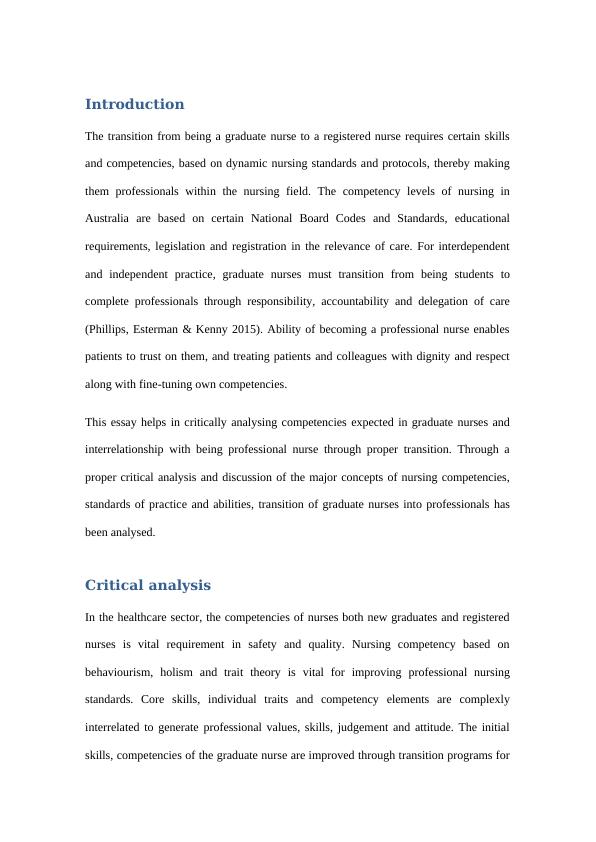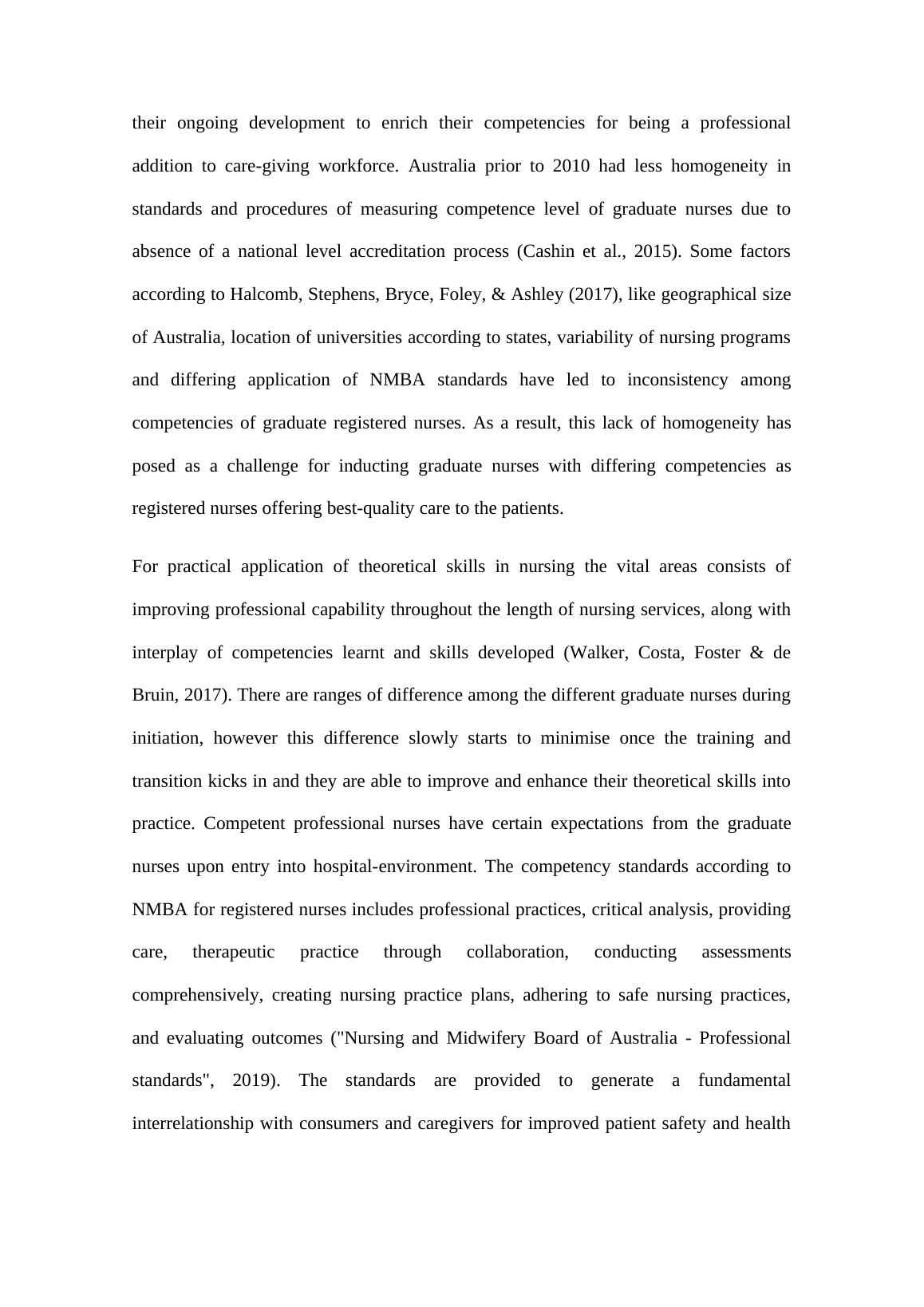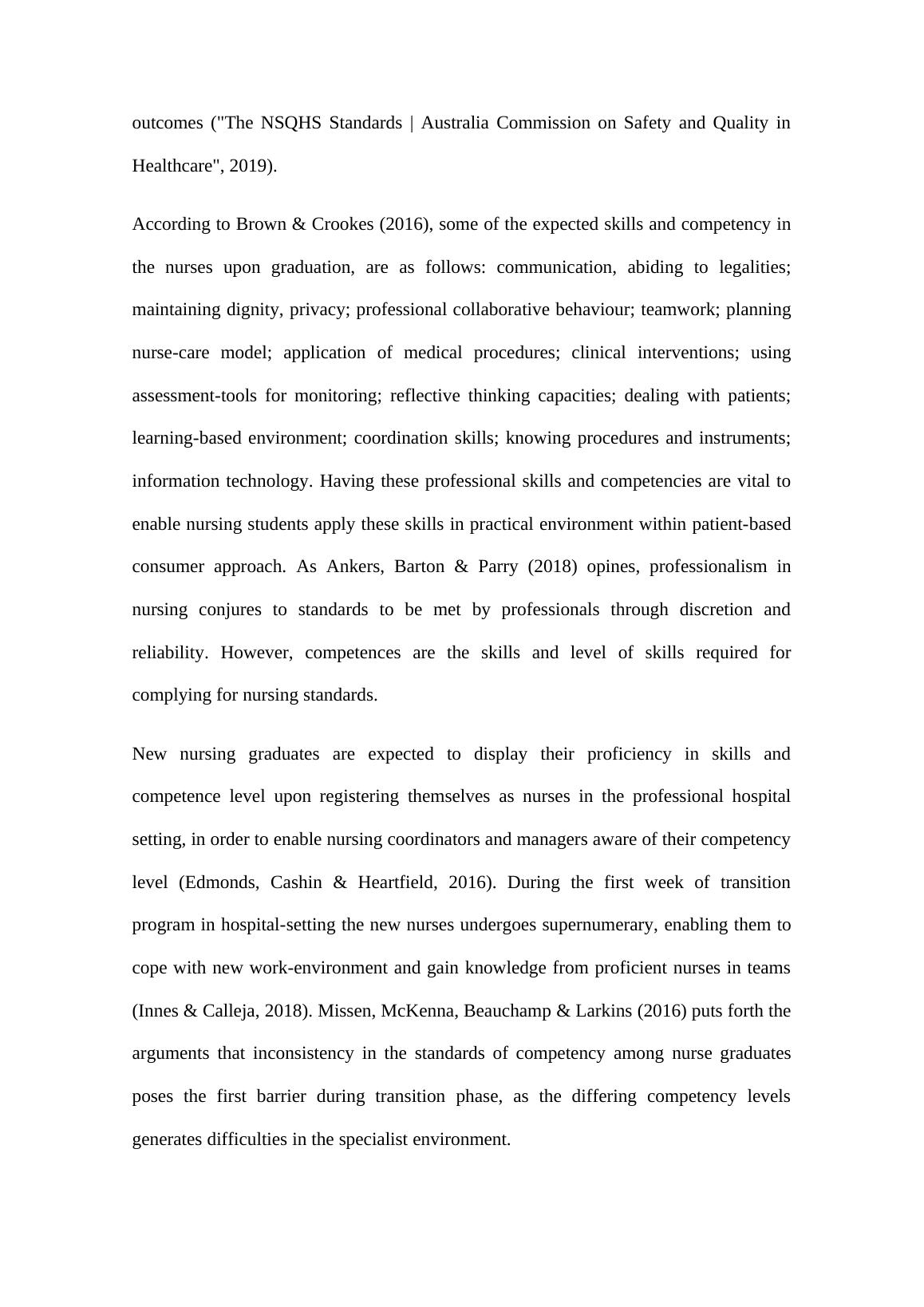Interrelationship between Competent and Professional Nurses: Case Study of Graduate Nurses Transition to Registered Nurse
Added on 2022-10-02
11 Pages2648 Words400 Views
Critical analysis of
interrelationship between
competent and professional
nurses
Case study of Graduate Nurses transition to Registered Nurse
interrelationship between
competent and professional
nurses
Case study of Graduate Nurses transition to Registered Nurse

Introduction
The transition from being a graduate nurse to a registered nurse requires certain skills
and competencies, based on dynamic nursing standards and protocols, thereby making
them professionals within the nursing field. The competency levels of nursing in
Australia are based on certain National Board Codes and Standards, educational
requirements, legislation and registration in the relevance of care. For interdependent
and independent practice, graduate nurses must transition from being students to
complete professionals through responsibility, accountability and delegation of care
(Phillips, Esterman & Kenny 2015). Ability of becoming a professional nurse enables
patients to trust on them, and treating patients and colleagues with dignity and respect
along with fine-tuning own competencies.
This essay helps in critically analysing competencies expected in graduate nurses and
interrelationship with being professional nurse through proper transition. Through a
proper critical analysis and discussion of the major concepts of nursing competencies,
standards of practice and abilities, transition of graduate nurses into professionals has
been analysed.
Critical analysis
In the healthcare sector, the competencies of nurses both new graduates and registered
nurses is vital requirement in safety and quality. Nursing competency based on
behaviourism, holism and trait theory is vital for improving professional nursing
standards. Core skills, individual traits and competency elements are complexly
interrelated to generate professional values, skills, judgement and attitude. The initial
skills, competencies of the graduate nurse are improved through transition programs for
The transition from being a graduate nurse to a registered nurse requires certain skills
and competencies, based on dynamic nursing standards and protocols, thereby making
them professionals within the nursing field. The competency levels of nursing in
Australia are based on certain National Board Codes and Standards, educational
requirements, legislation and registration in the relevance of care. For interdependent
and independent practice, graduate nurses must transition from being students to
complete professionals through responsibility, accountability and delegation of care
(Phillips, Esterman & Kenny 2015). Ability of becoming a professional nurse enables
patients to trust on them, and treating patients and colleagues with dignity and respect
along with fine-tuning own competencies.
This essay helps in critically analysing competencies expected in graduate nurses and
interrelationship with being professional nurse through proper transition. Through a
proper critical analysis and discussion of the major concepts of nursing competencies,
standards of practice and abilities, transition of graduate nurses into professionals has
been analysed.
Critical analysis
In the healthcare sector, the competencies of nurses both new graduates and registered
nurses is vital requirement in safety and quality. Nursing competency based on
behaviourism, holism and trait theory is vital for improving professional nursing
standards. Core skills, individual traits and competency elements are complexly
interrelated to generate professional values, skills, judgement and attitude. The initial
skills, competencies of the graduate nurse are improved through transition programs for

their ongoing development to enrich their competencies for being a professional
addition to care-giving workforce. Australia prior to 2010 had less homogeneity in
standards and procedures of measuring competence level of graduate nurses due to
absence of a national level accreditation process (Cashin et al., 2015). Some factors
according to Halcomb, Stephens, Bryce, Foley, & Ashley (2017), like geographical size
of Australia, location of universities according to states, variability of nursing programs
and differing application of NMBA standards have led to inconsistency among
competencies of graduate registered nurses. As a result, this lack of homogeneity has
posed as a challenge for inducting graduate nurses with differing competencies as
registered nurses offering best-quality care to the patients.
For practical application of theoretical skills in nursing the vital areas consists of
improving professional capability throughout the length of nursing services, along with
interplay of competencies learnt and skills developed (Walker, Costa, Foster & de
Bruin, 2017). There are ranges of difference among the different graduate nurses during
initiation, however this difference slowly starts to minimise once the training and
transition kicks in and they are able to improve and enhance their theoretical skills into
practice. Competent professional nurses have certain expectations from the graduate
nurses upon entry into hospital-environment. The competency standards according to
NMBA for registered nurses includes professional practices, critical analysis, providing
care, therapeutic practice through collaboration, conducting assessments
comprehensively, creating nursing practice plans, adhering to safe nursing practices,
and evaluating outcomes ("Nursing and Midwifery Board of Australia - Professional
standards", 2019). The standards are provided to generate a fundamental
interrelationship with consumers and caregivers for improved patient safety and health
addition to care-giving workforce. Australia prior to 2010 had less homogeneity in
standards and procedures of measuring competence level of graduate nurses due to
absence of a national level accreditation process (Cashin et al., 2015). Some factors
according to Halcomb, Stephens, Bryce, Foley, & Ashley (2017), like geographical size
of Australia, location of universities according to states, variability of nursing programs
and differing application of NMBA standards have led to inconsistency among
competencies of graduate registered nurses. As a result, this lack of homogeneity has
posed as a challenge for inducting graduate nurses with differing competencies as
registered nurses offering best-quality care to the patients.
For practical application of theoretical skills in nursing the vital areas consists of
improving professional capability throughout the length of nursing services, along with
interplay of competencies learnt and skills developed (Walker, Costa, Foster & de
Bruin, 2017). There are ranges of difference among the different graduate nurses during
initiation, however this difference slowly starts to minimise once the training and
transition kicks in and they are able to improve and enhance their theoretical skills into
practice. Competent professional nurses have certain expectations from the graduate
nurses upon entry into hospital-environment. The competency standards according to
NMBA for registered nurses includes professional practices, critical analysis, providing
care, therapeutic practice through collaboration, conducting assessments
comprehensively, creating nursing practice plans, adhering to safe nursing practices,
and evaluating outcomes ("Nursing and Midwifery Board of Australia - Professional
standards", 2019). The standards are provided to generate a fundamental
interrelationship with consumers and caregivers for improved patient safety and health

outcomes ("The NSQHS Standards | Australia Commission on Safety and Quality in
Healthcare", 2019).
According to Brown & Crookes (2016), some of the expected skills and competency in
the nurses upon graduation, are as follows: communication, abiding to legalities;
maintaining dignity, privacy; professional collaborative behaviour; teamwork; planning
nurse-care model; application of medical procedures; clinical interventions; using
assessment-tools for monitoring; reflective thinking capacities; dealing with patients;
learning-based environment; coordination skills; knowing procedures and instruments;
information technology. Having these professional skills and competencies are vital to
enable nursing students apply these skills in practical environment within patient-based
consumer approach. As Ankers, Barton & Parry (2018) opines, professionalism in
nursing conjures to standards to be met by professionals through discretion and
reliability. However, competences are the skills and level of skills required for
complying for nursing standards.
New nursing graduates are expected to display their proficiency in skills and
competence level upon registering themselves as nurses in the professional hospital
setting, in order to enable nursing coordinators and managers aware of their competency
level (Edmonds, Cashin & Heartfield, 2016). During the first week of transition
program in hospital-setting the new nurses undergoes supernumerary, enabling them to
cope with new work-environment and gain knowledge from proficient nurses in teams
(Innes & Calleja, 2018). Missen, McKenna, Beauchamp & Larkins (2016) puts forth the
arguments that inconsistency in the standards of competency among nurse graduates
poses the first barrier during transition phase, as the differing competency levels
generates difficulties in the specialist environment.
Healthcare", 2019).
According to Brown & Crookes (2016), some of the expected skills and competency in
the nurses upon graduation, are as follows: communication, abiding to legalities;
maintaining dignity, privacy; professional collaborative behaviour; teamwork; planning
nurse-care model; application of medical procedures; clinical interventions; using
assessment-tools for monitoring; reflective thinking capacities; dealing with patients;
learning-based environment; coordination skills; knowing procedures and instruments;
information technology. Having these professional skills and competencies are vital to
enable nursing students apply these skills in practical environment within patient-based
consumer approach. As Ankers, Barton & Parry (2018) opines, professionalism in
nursing conjures to standards to be met by professionals through discretion and
reliability. However, competences are the skills and level of skills required for
complying for nursing standards.
New nursing graduates are expected to display their proficiency in skills and
competence level upon registering themselves as nurses in the professional hospital
setting, in order to enable nursing coordinators and managers aware of their competency
level (Edmonds, Cashin & Heartfield, 2016). During the first week of transition
program in hospital-setting the new nurses undergoes supernumerary, enabling them to
cope with new work-environment and gain knowledge from proficient nurses in teams
(Innes & Calleja, 2018). Missen, McKenna, Beauchamp & Larkins (2016) puts forth the
arguments that inconsistency in the standards of competency among nurse graduates
poses the first barrier during transition phase, as the differing competency levels
generates difficulties in the specialist environment.

End of preview
Want to access all the pages? Upload your documents or become a member.
Related Documents
Transiting from Student RN to Graduate RNlg...
|9
|2188
|482
Nursing and Midwifery Board of Australia and Australian Nursing and Midwifery Federation: Roles and Standardslg...
|8
|1783
|401
Transition to Professional Nursing | Assignmentlg...
|9
|2039
|108
Role and Responsibilities of a Graduate RN in Nursinglg...
|9
|2453
|41
Reflecting on my nursing placementslg...
|10
|2543
|122
Assessment 2: New Graduate Applicationlg...
|7
|1476
|420
